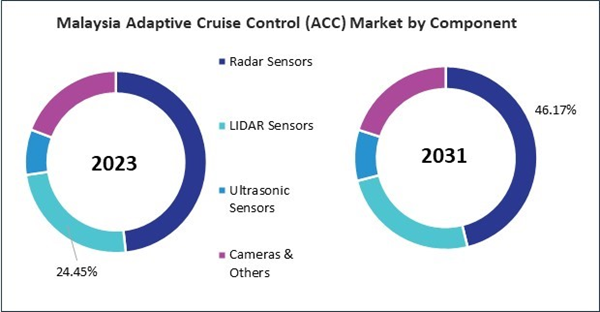The Asia Pacific Adaptive Cruise Control (ACC) Market is expected to witness market growth of 17.4% CAGR during the forecast period (2024-2031).
The China market dominated the Asia Pacific Adaptive Cruise Control (ACC) Market by country in 2023, and is expected to continue to be a dominant market till 2031; thereby, achieving a market value of $6.60 billion by 2031. The Japan market is registering a CAGR of 16.7% during 2024-2031. Additionally, the India market is expected to showcase a CAGR of 18.3% during 2024-2031.
The adoption of ACC has seen a steady rise across various regions, especially in developed countries. While the technology was initially available only in luxury cars, it is now integrated into many vehicles, including mid-tier models and even entry-level cars. The demand for advanced safety features in vehicles is one of the primary reasons behind the growing adoption of ACC systems. Consumers are increasingly aware of the need for technologies to reduce the risk of accidents, and systems like ACC provide significant value in this regard.
Automakers rapidly incorporate ACC systems into their vehicle portfolios to meet consumer expectations and regulatory standards. Governments are introducing stringent regulations encouraging the integration of Advanced Driver Assistance Systems (ADAS), including ACC, to improve road safety.
India's rapidly growing automotive market is increasingly prioritizing road safety. With the alarming rise in road accidents, the adoption of ADAS, like ACC, is expected to grow significantly. As per the Ministry of Road Transport & Highways' "Road Accidents in India-2022" report, India reported 4,61,312 road accidents, leading to 1,68,491 fatalities and 4,43,366 injuries. This increase in accidents underscores the need for advanced technologies to enhance road safety and mitigate the risk of human error. China is rapidly becoming a key player in the adaptive cruise control (ACC) market, driven by its ambitious push towards automotive automation and growing consumer demand for advanced vehicle technologies. In conclusion, rising road accidents and increasing autonomous vehicles in the region drive the market's growth.
The China market dominated the Asia Pacific Adaptive Cruise Control (ACC) Market by country in 2023, and is expected to continue to be a dominant market till 2031; thereby, achieving a market value of $6.60 billion by 2031. The Japan market is registering a CAGR of 16.7% during 2024-2031. Additionally, the India market is expected to showcase a CAGR of 18.3% during 2024-2031.
The adoption of ACC has seen a steady rise across various regions, especially in developed countries. While the technology was initially available only in luxury cars, it is now integrated into many vehicles, including mid-tier models and even entry-level cars. The demand for advanced safety features in vehicles is one of the primary reasons behind the growing adoption of ACC systems. Consumers are increasingly aware of the need for technologies to reduce the risk of accidents, and systems like ACC provide significant value in this regard.
Automakers rapidly incorporate ACC systems into their vehicle portfolios to meet consumer expectations and regulatory standards. Governments are introducing stringent regulations encouraging the integration of Advanced Driver Assistance Systems (ADAS), including ACC, to improve road safety.
India's rapidly growing automotive market is increasingly prioritizing road safety. With the alarming rise in road accidents, the adoption of ADAS, like ACC, is expected to grow significantly. As per the Ministry of Road Transport & Highways' "Road Accidents in India-2022" report, India reported 4,61,312 road accidents, leading to 1,68,491 fatalities and 4,43,366 injuries. This increase in accidents underscores the need for advanced technologies to enhance road safety and mitigate the risk of human error. China is rapidly becoming a key player in the adaptive cruise control (ACC) market, driven by its ambitious push towards automotive automation and growing consumer demand for advanced vehicle technologies. In conclusion, rising road accidents and increasing autonomous vehicles in the region drive the market's growth.
List of Key Companies Profiled
- Autoliv, Inc.
- Magna International, Inc.
- Robert Bosch GmbH
- Continental AG
- Denso Corporation
- Valeo SA
- Aptiv PLC
- ZF Friedrichshafen AG
- Tesla, Inc.
- Nidec Motor Corporation
Market Report Segmentation
By Product Sales
- OEMs (Original Equipment Manufacturers)
- Aftermarket
By Type
- Standalone ACC
- Integrated ACC
By Component
- Radar Sensors
- LIDAR Sensors
- Ultrasonic Sensors
- Cameras & Others
By Vehicle Type
- Passenger Car
- Commercial Vehicle
By Country
- China
- Japan
- India
- South Korea
- Australia
- Malaysia
- Rest of Asia Pacific
Table of Contents
Chapter 1. Market Scope & Methodology
Chapter 2. Market at a Glance
Chapter 3. Market Overview
Chapter 4. Competition Analysis - Global
Chapter 5. Asia Pacific Adaptive Cruise Control (ACC) Market by Product Sales
Chapter 6. Asia Pacific Adaptive Cruise Control (ACC) Market by Type
Chapter 7. Asia Pacific Adaptive Cruise Control (ACC) Market by Component
Chapter 8. Asia Pacific Adaptive Cruise Control (ACC) Market by Vehicle Type
Chapter 9. Asia Pacific Adaptive Cruise Control (ACC) Market by Country
Chapter 10. Company Profiles
Companies Mentioned
Some of the leading companies profiled in this Asia-Pacific Adaptive Cruise Control (ACC) Market report include:- Autoliv, Inc.
- Magna International, Inc.
- Robert Bosch GmbH
- Continental AG
- Denso Corporation
- Valeo SA
- Aptiv PLC
- ZF Friedrichshafen AG
- Tesla, Inc.
- Nidec Motor Corporation
Methodology

LOADING...









